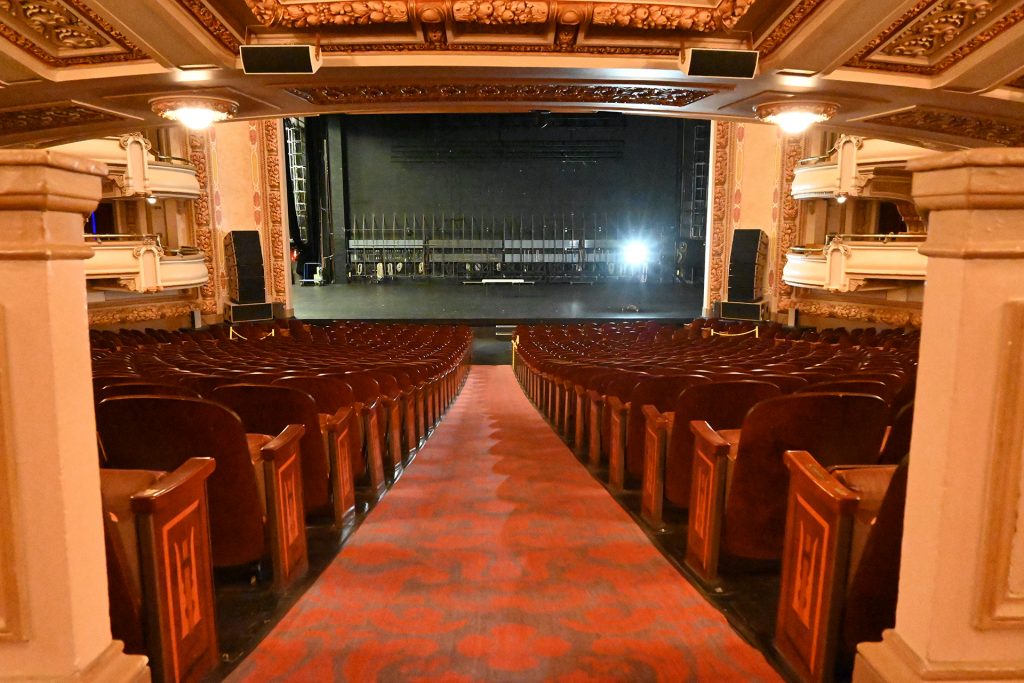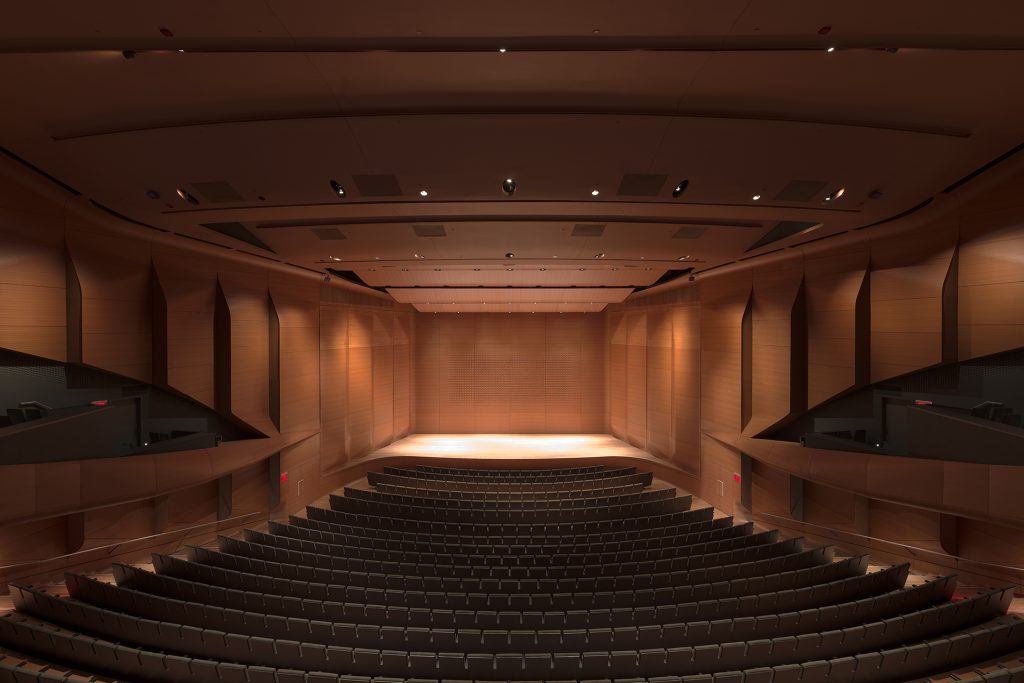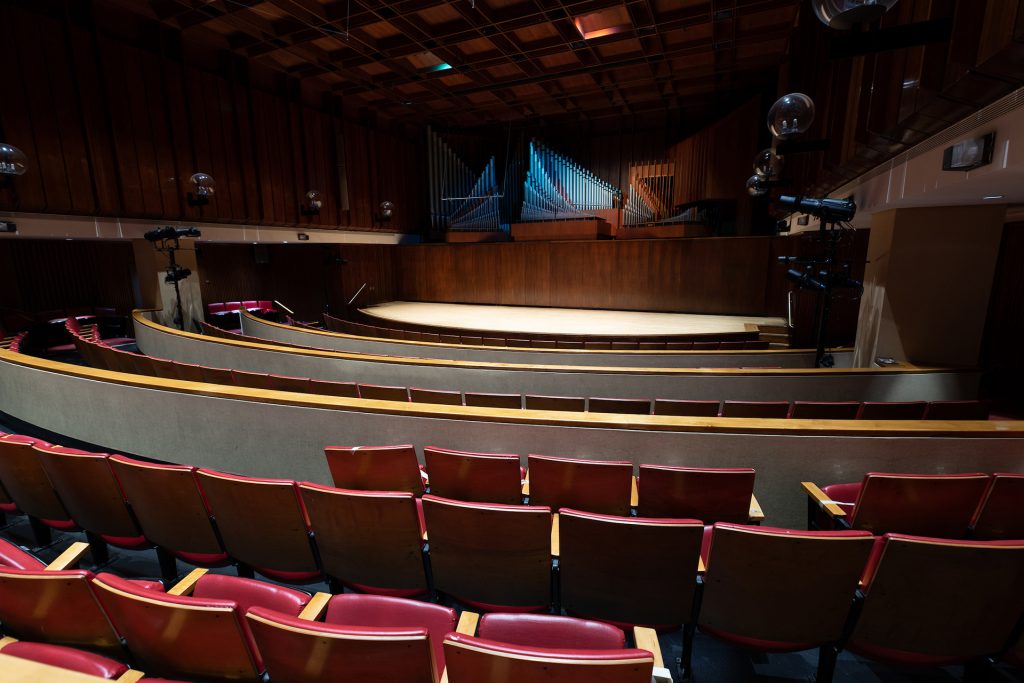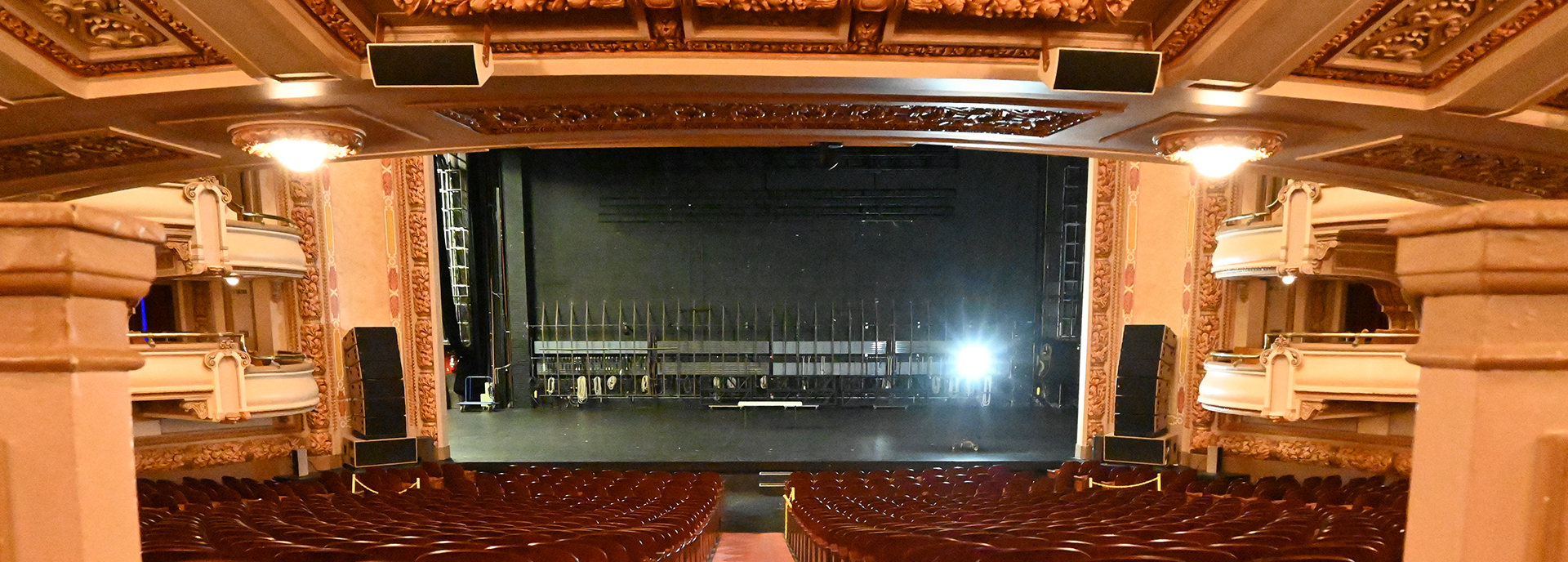Educational campuses have frequently been compared to and described as “small cities.” They have offices, classrooms, residences, dining facilities, sports arenas, parks and athletic fields, gyms, roads, sidewalks, traffic, power plants, sewage distribution, solid waste collection—and performing arts centers.
Facilities professionals who work in educational settings need to have an eclectic understanding of how various facility types function and the requirements needed for their upkeep. Just as facilities professionals work with the athletics department to ensure the basketball court, baseball diamond, and football field are maintained and ready for play before each contest, they also need to work with the arts departments to ensure their facilities are ready each time the curtain goes up.
Types of Facilities
There are many types of performing arts facilities, and for this article we will limit our discussion to those that host a performance for an audience. Below is a list of the more common space types, but it is important to note that variations and other types exist beyond this list.
Proscenium Theaters – Auditoriums that are highly complex. There is a high degree of technology in the stage and house areas. They host the widest variety of performance types.

BAM Peter Jay Sharp Building; Provided Courtesy of the BAM Hamm Archives
Concert Halls – Auditoriums uniquely situated for predominantly music productions. They tend to have more extensive acoustic and sightline requirements as a result.

Alice Tully Hall: Provided Courtesy of Lincoln Center, Photo by Iñakii Vinaixa
Recital Halls – Small- to moderate-sized auditoriums similar to concert halls. They are situated for small performances including chamber music, solo recitals, and other small group or small audience presentations.

Juilliard Paul Hall: Provided Courtesy of The Juilliard School, Photo Credit: Claudio Papapietro
Studios – Highly flexible areas where a multitude of activities can take place; they can be large or small spaces but are not typically smaller than a few hundred square feet in size. They can be places for rehearsal and instruction and then be set up as small-scale performance venues. They are typically lower tech but not necessarily devoid of theatrical technologies. They may have lighting systems that are simpler than those found in their larger counterparts. They typically require considerably more maintenance than your average classroom because of the turnover and setup/strike that is required to convert the space.
Amphitheaters – Outdoor auditoriums of varying sizes. Technical requirements can be simple or complex, depending on the venue. The outdoor nature of the performance creates complications with lighting control, maintenance, crowd control, seasonal availability, and other factors.
Characteristics Unique to Performing Arts Facilities
In many ways, facilities management in performing arts facilities is not all that different than it is in other facilities1. The laws of thermodynamics in our HVAC systems are not different in performing arts facilities. General cleaning principles remain largely unchanged; the wet side of the mop still goes down. The lawns still need to be mowed and the snow needs to be shoveled. Roofs leak. Pipes break. Lights burn out. All these things happen whether you are working in a performing arts facility or any other type of facility.
That being said, there are several key characteristics in performing arts facilities that are unique but important to know. For example, fan systems do control climate comfort but also may need to be adjusted to manage haze, smoke, or other onstage effects. One critical key to success in any facilities management effort is building relationships with stakeholders. One of the greatest barriers to building these relationships can be a lack of common foundational knowledge of the stakeholder’s vernacular and an unfamiliarity with their needs.
Below some are key terms and building elements that help provide an important foundational understanding needed when working with constituents in performing arts. Not all venues have these elements, but these are the more common ones you might find.
- The house – The location where the audience observes the performance.
- The stage – The place where the performance takes place.
- Front of house – Public areas accessible to guests and audience members.
- Back of house – Areas that are only accessible to artists, stage crew, and staff.
- House right/left – The area in the house to the right or left of center from the audience’s perspective.
- Stage right/left – The area on the stage to the right or left of center from the artist’s perspective when facing the audience.
- Upstage/Downstage – The area of the stage away from the audience (upstage) and toward the audience (downstage).
- Fly system – A system of ropes, pulleys, grids, and machines to the right and/or left of the stage that bring in and take out lights, scenery, and other artistic elements.
- Fly loft – The area above the stage that contains lighting, scenic material, and other elements that rise above the stage.
- Trap – The area below the stage sometimes used for artistic effects, such as rising up or falling through the floor.
- Pit (aka orchestra pit) – The area, typically downstage, that is depressed below the stage level. While this is typically where musicians perform when artists are performing on the stage, the pit area can be employed for other creative uses.
- Lighting grid – A system of infrastructure to hang lighting and provide power to theatrical lighting and audio/visual instruments.
- Dimmer system – Primary lighting control for theatrical lighting. May also tie into architectural lighting systems. Found predominantly in incandescent systems. LED systems tend to have addressable lamps and do not need dimmers but rather have direct control over the individual fixture.
- Control booth – Could be a variety of control booths including sound, lighting, and spot booths. They are typically designed to be acoustically isolated where possible so the crew can discuss the production without disrupting the presentation.
- Catwalk – The area above the stage and house where the stage crew will access overhead lighting and sound instruments as well as other theatrical elements.
- Gantry – A moving catwalk that can provide greater access without the need for additional catwalks or lift equipment.
- In tech – The process of the production department and artists working together to ensure stage elements are coming together. It can be lighting focus, sound check, rehearsal, dress rehearsal, or other activities in preparation for the performance.
Unique Operational Requirements
Similar to other areas of the campus such as athletics, performing arts facilities have requirements outside the normal course of business. They tend to have unique hours of operation, staffing needs, regulatory requirements, and other operational demands. Below are some of the common conditions found unique to performing arts facilities.
Hours of Operation. Perhaps the most obvious operational difference with performing arts centers is in their hours of operation. Many activities do occur during regular business hours, Monday through Friday. However, performances and other events typically occur after hours to allow those who are otherwise occupied during business hours to enjoy the center’s offerings; this makes scheduling and other operational demands challenging. Staffing can be regularly scheduled after hours or on overtime. Every operation is different and will need to decide what model is best for them.
Load-ins/Load-outs. One unique but key operational difference with performing arts centers is the need to manage large and complex load-ins and load-outs. These are events that take place before and after a large production, and can include scenery, props, costumes, lighting equipment, and a host of other items needed to put on a production. Some of these things can be manufactured or stored onsite in one of the shops, but many times they are also brought in. It takes coordinating trucks, parking, traffic, labor, delivery timing, and all logistical factors well in advance so there are no traffic jams at the time of the load. It can be highly complex and takes a great deal of skill and planning to pull off well.
Public Assembly. In most municipalities, there are codes and regulations for hosting large audiences above a certain size. In New York City, for example, any room, not just auditorium, that holds more than 74 people is required to be certified as a Place of Assembly (PA). With that certification comes building codes that are different than those regulating other non-PA spaces. Similar certifications are found throughout the country and worldwide depending on the authority having jurisdiction (AHJ). Requirements for PA spaces might cover elements such as additional means of egress, fire alarm and suppression systems, emergency lighting and exit signage, and fire brigade and fire safety certification. It is good to have a solid understanding of the AHJ as it relates to the performing arts center to ensure compliance with applicable codes and regulations.
Security. Security has always been an important element of hosting public events. Different centers have taken various stances on the balance between safety and openness. However, that changed for many facilities on November 13, 2015, when terrorists attacked six locations in Paris including a concert hall.2 The attacks left 130 dead and hundreds more injured. In the wake of those attacks, performing arts centers throughout the United States have swung the pendulum more in the direction of safety and security, sometimes at the expense of an open and welcoming atmosphere.3 Some adjusted slightly, some greatly. Some patrons appreciated the changes; some did not. In this new reality, it is important to have a firm grasp on the threat possibilities and on the options for protecting any PA from attack. Before 2015, attacks on performing arts centers were always a theoretical possibility. After 2015, they became a reality. In addition to professional associations such as APPA and ASIS International, local law enforcement agencies can be exceptional consultants in this effort and provide threat assessments and guidance on protection options.
The arts and humanities define who we are as a people. That is the power of the arts—to remind us of what we each have to offer, and what we all have in common; to help us understand our history and imagine our future; to give us hope in the moments of struggle; and to bring us together when nothing else will.4
~Michelle Obama
HVAC. Something that is seldom considered as a unique condition for performing arts— but that is nevertheless worth mentioning—is the HVAC system. Creating a comfortable environment can be quite a challenge, and that is before we factor in any maintenance or deferred capital renewal needs. Finding a balance of comfort between the audience and artists takes skill. If the onstage activity includes period scenes with heavy wool costumes, cooling the stage will be a high priority—but things might get a little chilly for the audience. If the onstage activity consists of dancers who like it warmer, the audience may get uncomfortably warm. But cooling off the space for the sake of the audience may not only make the dancers cold, it may also cause their muscles to cramp, potentially causing injuries.
It is also important to have a firm grasp on the capabilities of your HVAC system for the space in question. If a show is being proposed that requires a lot of hot lights, and the artists are requesting temperatures down near 60ºF, can the system handle that? Also, it is important to understand the timing of your system. For example, opening the house a little on the cool side—when the audience comes in and their body heat consolidates in the space—is a good idea, so that the engineers do not need to play catch-up about an hour into the performance when calls start coming in from ushers. The bottom line is that HVAC systems are far from straightforward, and it takes experience and an in-depth familiarity with what is happening onstage in order to effectively manage and ensure all are comfortable and safe.
Power. Another complex technical issue for performing arts centers is power consumption. In this age of sustainability and the call to reduce carbon emissions, performing arts spaces are often limited in what they can conserve according to the options available to them. Only recently has LED lighting technology achieved a sufficiently advanced state to perform well in a theatrical setting. However, just because LED fixtures are available does not mean that the systems in place can accommodate them. While there may be plug-and-play options out there, there are times when a full-system changeover is required to begin to employ LEDs rather than power-sucking incandescent lighting. Along with the HVAC challenges mentioned above, it is no wonder that effective energy conservation measures (ECMs) are hard to come by in performing arts centers—but they are not unattainable.
Numerous grants and funding opportunities exist to help performing arts centers, especially those connected to educational campuses, complete these capital improvements. It is important to check with city, state, and national sources. In addition, power companies often offer rebates and incentives to implement a project plan. These opportunities are changing all the time, so it is invaluable to maintain good relationships with these agencies in order to receive updates on the latest offerings. Managing power consumption in a performing arts center can be incredibly complicated—far more complicated than doing so in a classroom or office complex. However, the opportunities abound, and the technology is developing in a way that is bringing these ECMs into reach. More information can be found in Part III of APPA’s Body of Knowledge, Energy, Utilities, and Environmental Stewardship.
Performing arts centers are an important part of our campus communities. They bring people together in a setting that highlights imagination, creativity, and discovery. Ensuring these arts facilities are well run is as much our duty as supporting athletics, dining, student unions, and other auxiliary facilities throughout our campuses.
References
1Christensen, Facilities Management for the Arts
2CNN Editorial Research, “2015 Paris Terror Attacks Fast Facts,” updated October 31, 2001, https://www.cnn.com/2015/12/08/europe/2015-paris-terror-attacks-fast-facts/index.html.
3Itay Hodd and Todd Cunningham, “Paris Attacks Change Hollywood’s Security Equation, Concert Calculus,” TheWrap, November 17, 2015, https://www.thewrap.com/paris-attacks-change-hollywoods-security-equation-concert-calculus/.
4Mike Boehm, “Michelle Obama Tells International Audience Why the Arts Matter,” Culture Monster (blog), Los Angeles Times, September 25, 2009, https://www.latimes.com/archives/blogs/culture-monster-blog/story/2009-09-25/michelle-obama-tells-international-audience-why-the-arts-matter.
Cameron Christensen is associate vice president for facilities at The Juilliard School, New York, NY. He can be reached at [email protected].



